Types of Wasps and How to Identify Them (Pictures and Names)

Wasps are small, flying insects that usually have an identifiable black body with yellow bands. Typically, wasps have a slender, smooth body with a narrow waist, a pair of membranous wings, and six spindly legs. Many species of wasps look like bees, and both wasps and bees are important pollinators that can cause a painful sting.
Identifying species of wasps is essential because some wasps are more dangerous than others. For example, the bald-faced hornet (Dolichovespula maculata) is a black and white wasp that can attack in swarms to defend a nest. Similarly, yellowjackets (Vespula maculifrons) tend to be aggressive wasps that sting unprovoked. In contrast, the black and yellow paper wasp (Polistinae) is relatively docile and harmless.
This article is a guide to identifying common species of wasps. Descriptions and pictures of different types of wasps will help to recognize these slender flying insects as they buzz from flower to flower in your garden.
How to Identify Wasps
Wasp identification is possible by looking at their shape, size, color, and habits. Most wasp species have smooth, slender bodies, making them easy to tell apart from bees. The easily identifiable feature of wasps is their thin waist between the thorax and abdomen. Wasps are usually yellow and black. But some species are black, red, or brown.
Other identifiable features of wasps are their six spindly legs. Depending on the species, wasp legs can be black, orange, or yellow. In addition, many wasps have bi-colored legs, which is another way to identify a particular species.
Wasps vs. Hornets
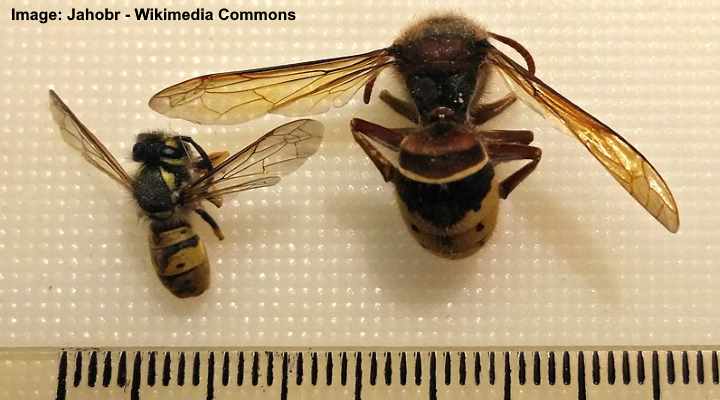
Size comparison of wasp (left) and hornet (right)
Hornets are a type of wasp that differ in size and color. Typically, hornets are giant wasps that can measure 1.6” (3.8 cm) in length, compared to a typical wasp that is 0.4” (1 cm) long or smaller. Additionally, hornets tend to have black bodies and white rings, whereas wasps are generally yellow and black.
Although wasps and hornets have a reputation for being aggressive, some species of wasps are more aggressive than hornets. For example, a European hornet can inject a powerful sting. But it usually only attacks to defend the nest. On the other hand, some wasp species can sting without warning.
Wasps vs. Bees
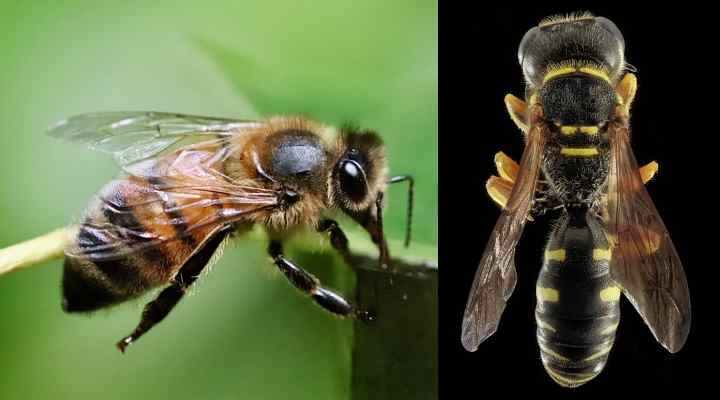
Close up pictures of a honey bee (left) and a wasp (right)
The main differences between bees and wasps are their body shape and appearance. Bees usually have a fuzzy body that is more barrel-shaped than slender. For example, bees don’t have a recognizable thin waist like wasps.
Facts About Wasps
Wasps are flying winged insects in the order Hymenoptera and are related to bees and ants. Wasps range in size from the tiny chalcid wasp measuring 0.005” (0.139 mm) to the enormous female cicada killer wasp that can be 2” (5 cm) long. Generally, wasps are solitary insects, although some species are social creatures that nest together.
Although wasps have a reputation for aggressiveness, they are crucial insects in many ecosystems. For example, some species of wasps help pollinate several plant species. Some types of wasps store pollen and nectar in their bodies. Additionally, fig wasps (Agaonidae) are crucial for pollinating figs.
Some species of parasitoid wasps and predator wasps can help reduce the number of common garden pests. For example, by encouraging parasitic wasps, you can help reduce caterpillar populations and the number of ants in your garden by feeding on larvae.
Types of Wasps and How to Identify Them (Pictures)
Let’s look in more detail at how to identify various types of wasps. You will learn about common yellowjackets that tend to annoy people in the summer to smaller harmless wasps that look like flies or ants.
Paper Wasps (Polistinae)

There are many species of paper wasps that vary in their appearance
Paper wasps are a group of vespid wasps that typically have slender black or dark-brown bodies and yellow bands. Paper wasps are identified by their thin waist, orange-tipped antennae, and long brownish wings. Also, unlike yellowjackets, paper wasps dangle their long legs when they fly.
There are about 300 species of paper wasps in North America. The black or brown wasps are also known as umbrella wasps due to the shape of their papery nests.
Paper wasps get their name from their habit of constructing papery nests. The wasps chew on plant fiber or wood to create a thin, paper-like substance for nesting. Paper wasp nests are typically found in sheltered areas in attics, hanging from tree branches, or under eaves.
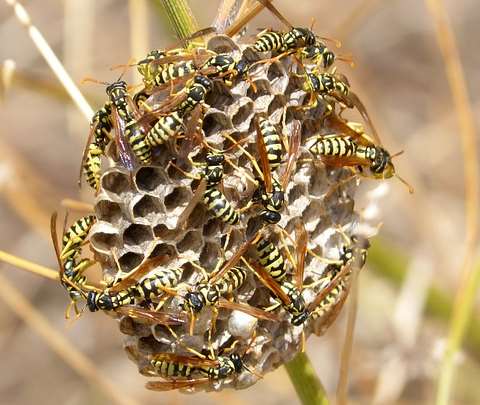
Paper wasp nest
Like most wasps, paper wasps have a stinger that can inflict a nasty, painful sting. Paper wasps tend to sting if the nest is under threat. The sting becomes red and swollen and can induce a severe allergic reaction in some people.
Wasp identification: Identify paper wasps by their slender brown or black body, yellow markings, thin waist, and long dangling legs when they fly. Paper wasps measure 0.8” to 1.2” (2 – 3 cm) long.
Northern Paper Wasp (Polistes fuscatus)

Northern Paper Wasp (Polistes fuscatus)
The northern paper wasp is a dark brown or black wasp with thin yellow bands, brownish wings, a characteristic slender abdomen, and a thin waist. You will also notice bright red spots on the wasp’s abdomen that help identify the species. Depending on the habitat, the wasps may have black bodies with no markings.
Northern paper wasps are commonly found in the eastern half of North America, from Florida in the south to British Columbia in the north.
Wasp identification: The northern paper wasp is a slender dark brown wasp with yellow bands and red dots on its abdomen. The wasps measure 0.6” to 0.8” (1.5 – 2 cm) long.
European Paper Wasp (Polistes dominula)

European Paper Wasp (Polistes dominula)
The European paper wasp is a social wasp with a black, yellow-spotted thorax, black and yellow abdomen, orange antennae, and orangey-yellow legs. This species of paper wasp is one of the most common in the US and is also one of the most aggressive paper wasps.
The paper wasp builds its papery nests in the spring, where the queen lays eggs and tends to her brood.
Wasp identification: European paper wasps have black and yellow bodies, orange antennae, and orange wings. The wasps measure between 0.3” and 0.5” (0.8 – 1.2 cm).
Black and Yellow Paper Wasp (Polistes Comanchus)
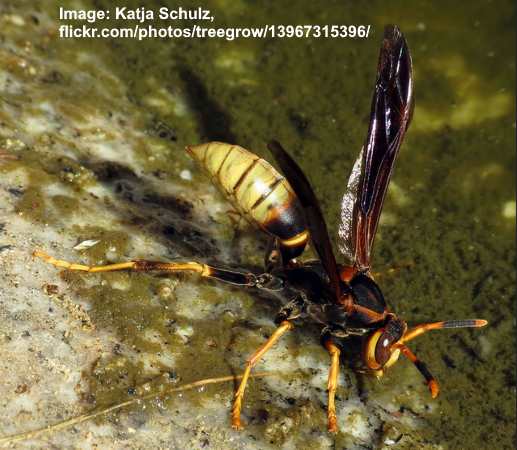
Black and Yellow Paper Wasp (Polistes Comanchus)
The appropriately named black and yellow paper wasp has a black thorax and brightly colored yellow abdomen. Like all paper wasps, this species, Polistes comanchus, has a thin waist between its abdomen and thorax and dark wings. Black and yellow paper wasps are found in the southern United States.
Wasp identification: The black and yellow paper wasp is identified by its black thorax, orange antennae, and yellow and orange abdomen with thin brown bands.
Yellow Paper Wasp (Polistes flavus)
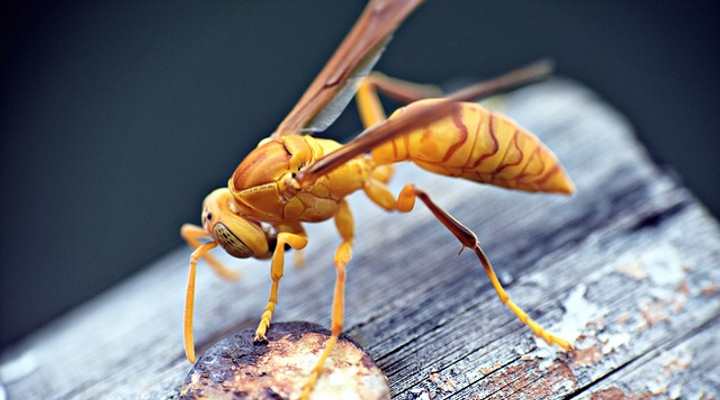
Yellow Paper Wasp (Polistes flavus)
The yellow paper wasp is a brightly colored sizeable vespid wasp with an orangey-yellow thorax, yellow abdomen, yellow legs, and brown wings. The bright yellow color of the wasp is its main identifying feature. The yellow wasps are generally found in Texas, Arizona, and New Mexico.
Wasp identification: The yellow wasp is easy to identify due to its yellow color and orange and brown markings. The large yellow wasps grow up to 1.2” (3 cm) long.
Guinea Paper Wasp (Polistes exclamans)
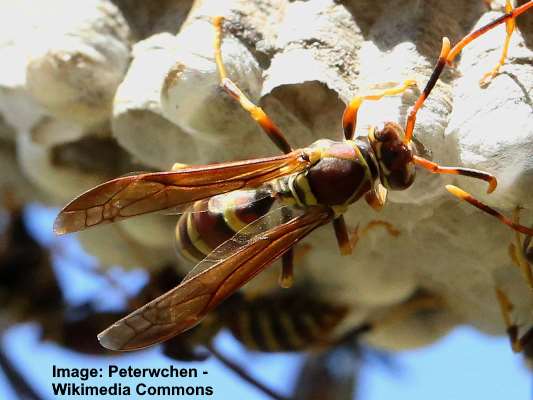
Guinea Paper Wasp (Polistes exclamans)
The Guinea paper wasp is an orangey-brown and yellow wasp with a striped abdomen and black marking on its thorax. This paper wasp species has the characteristic traits of paper wasps—a slender body, thin abdomen, and flattened triangular face. Guinea paper wasps have variations in color depending on their habitat.
An identifiable feature of the guinea paper wasp is its banded antennae with orange, yellow, and black colors. Most paper wasp species have antennae with only one color.
Wasp identification: You can identify the Guinea paper wasp by its banded slender yellow and orange-brown abdomen and colorful antennae with yellow tips. The wasps have a wingspan of 0.5” and 0.65” (1.3 – 1.6 cm).
Red Paper Wasp (Polistes carolina)
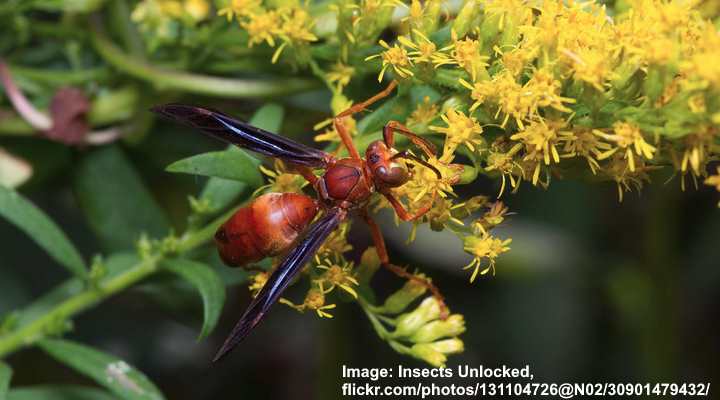
Red Paper Wasp (Polistes carolina)
As its common name suggests, the Polistes carolina is a red-colored wasp with black wings and red antennae. Although it stings, the red paper wasp isn’t classified as an aggressive wasp. Instead, it tends to build its oval papery nests near human habitation, for example, under eaves or roof overhangs.
Red paper wasps are stinging wasps, but only the females have stingers. The wasps generally don’t attack humans but will sting to defend the nest.
Wasp identification: The red wasp is easily identified by its reddish-brown body, lack of abdominal bands, and black wings. Red wasps measure 1” to 1.3” (2.5 – 3.2 cm) long.
Yellowjackets (Vespula spp.)
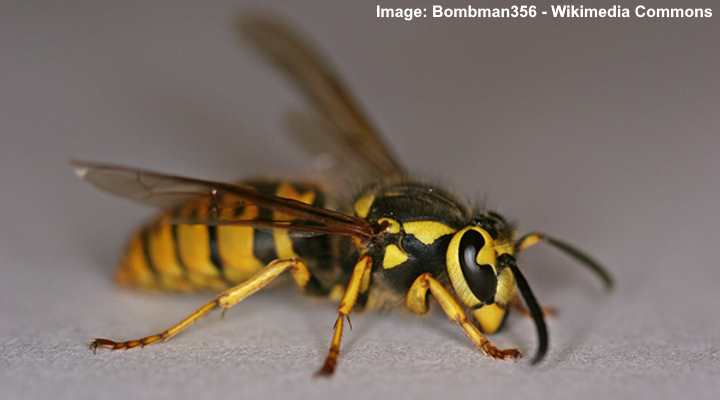
Eastern Yellowjacket (Vespula maculifrons)
Yellowjackets are a common type of wasp with black bodies and orangey-yellow bands. Eastern yellowjackets (Vespula maculifrons) are the typical black and yellow wasps that commonly become a pest in gardens. Of all the species of wasps, yellowjackets are the ones most mistaken for bees.
Yellowjackets have smooth bodies that help tell them apart from honeybees. Additionally, the wasps have a thinner abdomen and smaller size than honeybees or bumblebees.
Yellowjackets resemble some types of hornets. However, compared to the size of enormous hornets, yellowjackets are relatively small wasps.
Yellowjackets nest in the hollows of trees, holes in the ground, or cracks or crevices.
Wasp identification: Yellowjacket identification is by its black and yellow striped body, black antennae, and orange or yellow legs. Yellowjackets measure approximately 0.5” (1.2 cm) long.
Bald-Faced Hornet (Dolichovespula maculata)
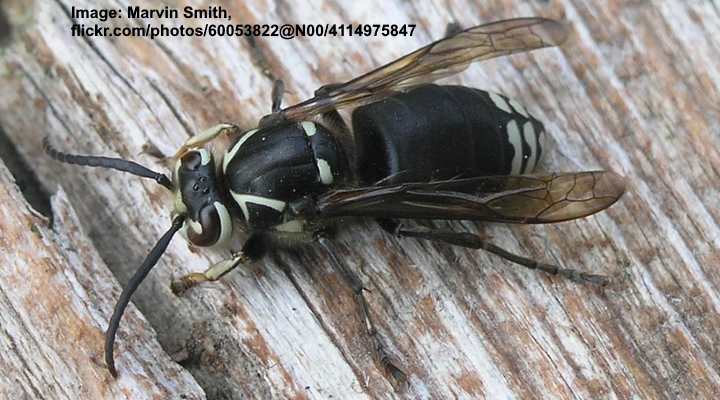
Bald-Faced Hornet (Dolichovespula maculata)
The bald-faced hornet is a black and white wasp with black antennae, flattened black face with a white stripe, and black and white legs. Despite its common name, this black wasp isn’t a true hornet in the genus Vespa. Instead, the bald-faced wasp is a type of yellowjacket, despite its black coloration.
Other names for the bald-faced hornet include white-faced hornet, white-tailed hornet, bald-faced aerial yellowjacket, and bald-faced wasp. The black and white wasps are found throughout North America. The “hornets” can be aggressive if the nest is threatened.
Bald-faced hornets build large paper nests that contain between 400 and 700 wasps. The hanging papery nests are often found high up in trees, under roof overhangs, or in wall cavities. The wasp nests consist of layered hexagonal combs covered in a gray, papery substance.
Wasp identification: Identify the bald-faced hornet by its black, smooth body, white facial patches, and three distinct white stripes on its abdomen’s tail end. Bald-faced wasps measure 0.8” to 1” (2 – 2.5 cm) long.
Giant Ichneumon Wasp (Megarhyssa macrurus)

Giant Ichneumon Wasp (Megarhyssa macrurus)
The giant ichneumon wasp is described as a “wasp with a long tail.” This brown wasp has a slender body with yellow and black markings giving it a colorful appearance. The identifying feature of the giant ichneumon is its tail or ovipositor. This tail-like protrusion is the same length as the wasp.
The giant ichneumon looks menacing because its tail looks like a stinger. However, this wasp’s long tail doesn’t contain venom but is for females to lay eggs under tree bark.
Wasp identification: The long-tailed giant ichneumon wasp is identified by its tail that can be over 2” (5 cm) long. The wasps measure over 5” (13 cm) long, including the ovipositor. Male wasps in the species measure 2” (5 cm) as they have no tail.
Mason Wasps (Eumenidae)
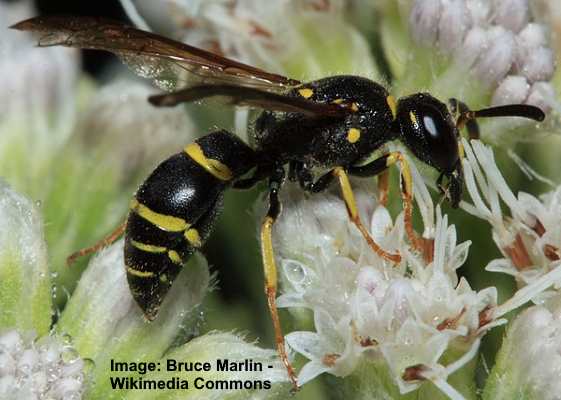
Mason Wasps (Eumenidae)
Mason wasps are a type of black wasp with yellow bands on its abdomen. Also called potter wasps, the species of black wasps contains variations in colors, including yellow, orange, red, or white markings. In addition, some black mason wasps have green or blue metallic shimmering colors.
Potter wasps and mason wasps get their name for their unusual nest-building habits. The small, slender striped insects build nests from mud that look like clay bottle vases made from pottery.
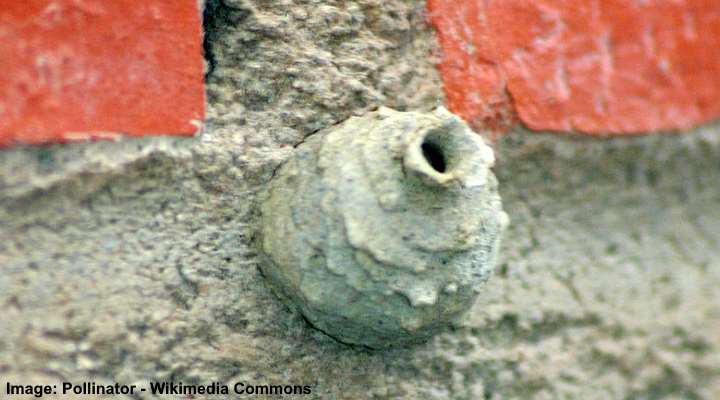
Mason Wasp Nest
Wasp identification: Mason wasps are identified by their black or brown smooth body with several colorful bands around their abdomen. The pottery nests are another way to identify the presence of potter wasps.
Black-and-Yellow Mud Dauber Wasp (Sceliphron caementarium)
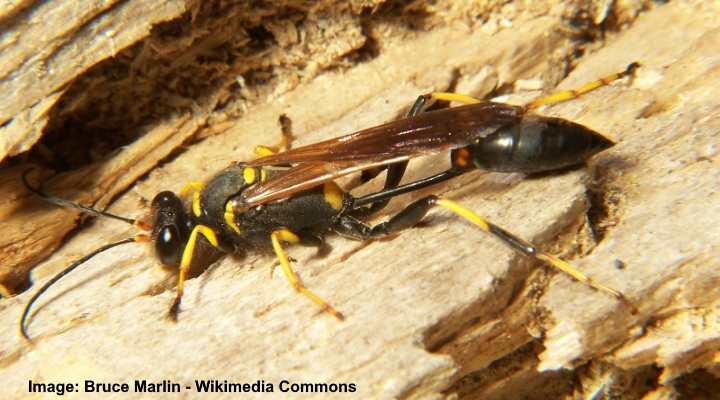
Mud Dauber Wasp (Sceliphron caementarium)
The black-and-yellow mud dauber is a black wasp with yellow legs and an identifiable long thin waist joining the thorax and abdomen. The mud dauber wasp has a black thorax with yellow markings. The long petiole (waist) is typically black but can also be yellow. The long wings are a dark tawny color.
The common name for this wasp comes from its habit of building nests from mud.
Wasp identification: The black-and-yellow mud dauber is easy to identify due to its black body, yellow legs, and thin petiole joining the abdomen and thorax. The wasps measure 0.9” to 1.1” (2.4 – 2.8 cm) long.
Blue-Winged Scoliid Wasp (Scolia dubia)
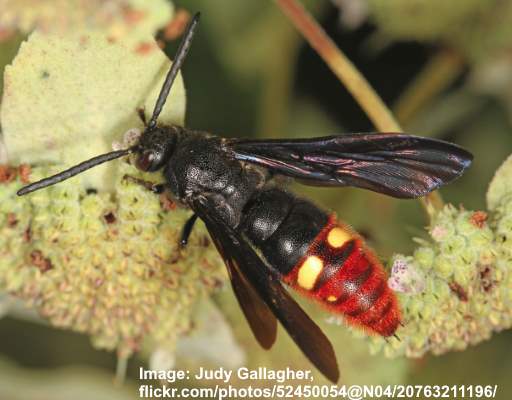
Blue-Winged Scoliid Wasp (Scolia dubia)
The blue-winged scoliid wasp is a large black and red wasp with two bright yellow spots on its colorful abdomen. The other identifying feature of the wasp is its iridescent blue wings that look almost black.
Blue-winged scoliid wasps are excellent parasitic wasps for controlling beetle populations. The female wasp burrows into the ground to lay eggs in the larvae of June beetles (Cotinis nitida) and Japanese beetles (Popillia japonica).
Wasp identification: The easily identifiable blue-winged scoliid wasp has dark blue wings, a black head and thorax, and a black and red abdomen with two yellow dots. Adult wasps measure up to 1” (2.5 cm) long.
Eastern Velvet Ant (Dasymutilla occidentalis)

Eastern Velvet Ant (Dasymutilla occidentalis)
The eastern velvet ant is a furry red and black parasitoid wasp that looks like an ant. The wingless female wasps have a red abdomen with an identifiable black band around the middle. The male eastern velvet ant wasps have similar coloration, but they can fly and have black wings.
Eastern velvet ants can give a nasty sting. This earns the red and black stinging wasp the name “cow killer.”
Wasp identification: The eastern velvet ant is easy to identify due to its fuzzy red thorax and red abdomen with a black band across it. The ant-like wasp has black spiny legs and two black antennae. The wasp measures 0.75” (1.9 cm) long.
Spider Wasp (Pompilidae)
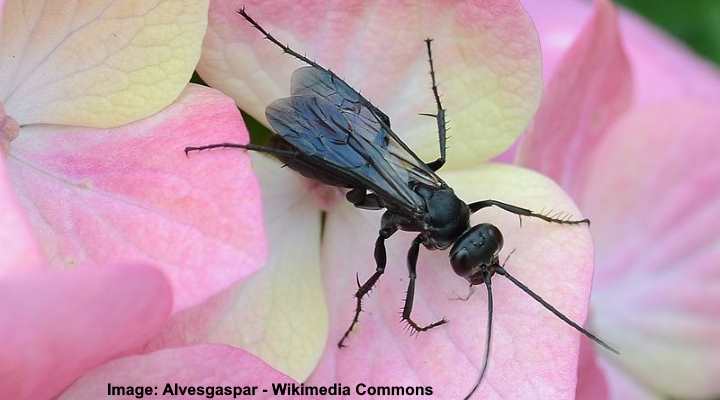
Spider wasp (Anoplius nigerrimus)
Spider wasp is a large family of pompilid wasps with black or dark blue bodies, large heads, and fuzzy black abdomens. Most wasps in the Pompilidae family have long, spiny legs and fine hairs covering the abdomen and hind legs. Some spider wasps have yellow, white, red, or orange markings.
Spider wasps are among the largest wasps, with some species being over 2” (5 cm) long.
Wasp identification: Spider wasps are generally identified by dark slender bodies, transparent-blackish wings and long spiny legs. A common identifying feature of spider wasps is the grooves on their bodies.
Cicada Killer Wasp (Sphecius)
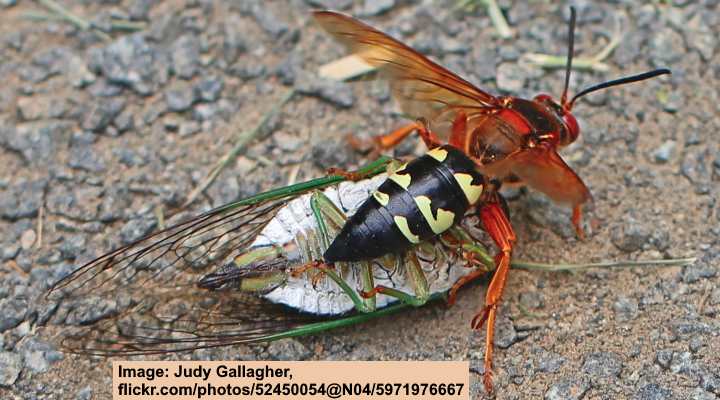
Eastern Cicada Killer (Sphecius speciosus) with a cicada
The eastern cicada killer wasp (Sphecius speciosus) is a common ground-dwelling wasp in North America. The black or brown wasp has yellow bands across its abdomen, black antennae, and transparent brown wings. The large wasps are easy to mistake for yellowjackets or hornets. The brown and yellow wasps grow up to 2” (5 cm) long.
Cicada killer wasps are among the largest wasps in North America.
Wasp identification: To identify a cicada killer wasp, look for its plump body, black or reddish-brown abdomen with yellow bands, and dark thorax with reddish markings.
Thread-Waisted Wasps (Ammophila procera)
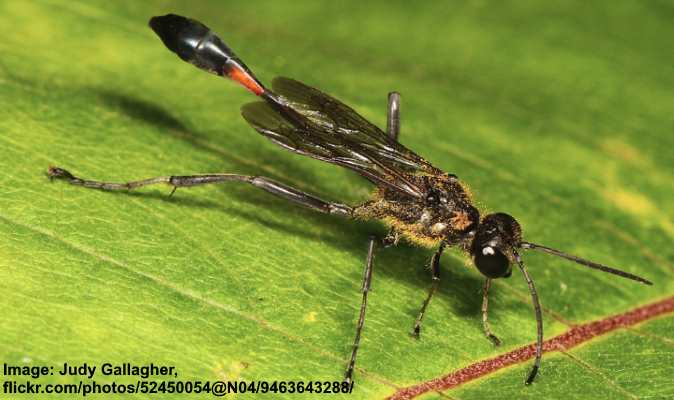
Thread-Waisted Wasps (Ammophila procera)
The slender thread-waisted wasp is a black wasp with a long waist attaching the abdomen and thorax. The spindly wasp has a black bulbous head, black antennae, and black abdomen with an orangey-red band across it. These wasps prey on their victims by injecting venom with their stingers and carrying the insects back to the nest.
Wasp identification: Thread-waisted wasps have an identifiable narrow waist, plump orange-banded abdomen, and long skinny legs. The wasps measure up to 1” (2.5 cm) long.
Braconid Wasp (Atanycolus spp.)
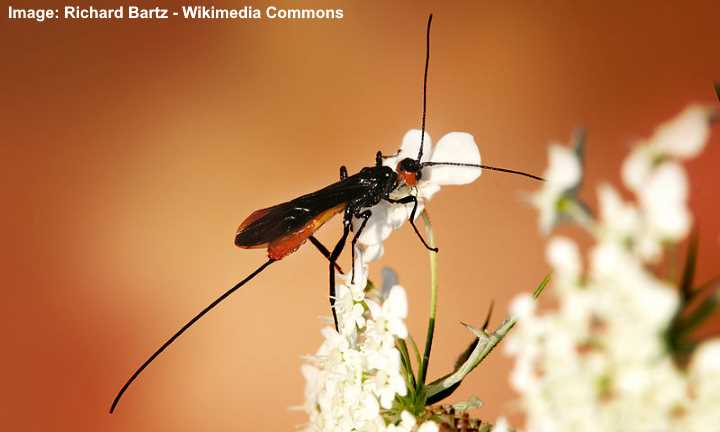
Braconid Wasp (Atanycolus spp.)
The Braconid wasp is an unusual species of wasp due to its small size, bright red abdomen, and dark gray to black wings. An easily identifiable feature of the braconid wasp is its long needle-like tube at the rear called an ovipositor. These solitary wasps are parasitoids and are classed as beneficial insects because they are a form of biological pest control.
Braconid wasps are small parasitic insects measuring 0.16” to 0.27” (4 – 7 mm) long. The males and females look similar, apart from the 0.23” (6 mm) long ovipositor that the females use to deposit their eggs inside insect larvae.
Wasp identification: A black and red braconid wasp has an easily recognizable slender body with dark wings and antennae and a bright orange-red body.
Southern Yellowjacket (Vespula squamosa)
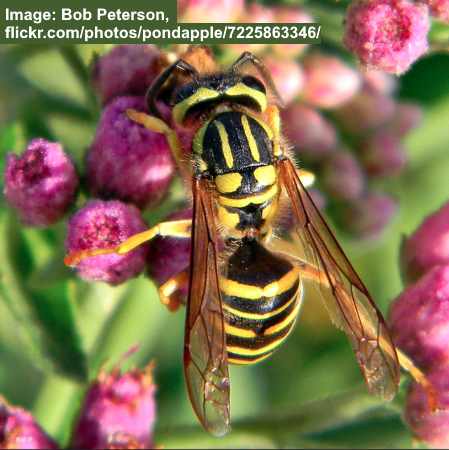
Southern Yellowjacket (Vespula squamosa)
The southern yellowjacket is a black wasp with bright yellow bands around its abdomen. Identifying features of this common wasp are its two yellow stripes on a yellow and black thorax, translucent brown wings, and yellow face. Native to the Southern United States, these black and yellow wasps measure 0.5” (13 mm) long.
Southern yellowjacket wasps primarily feed on caterpillars, ants, other insects, and larvae. However, they can deliver a nasty sting when provoked and can be a nuisance flying insect in the summer when they are most active.
Wasp identification: The southern yellowjacket is identified by its black and yellow striped body, yellow legs, and slender brown wings.
Red and Black Mason Wasp (Pachodynerus erynnis)

Red and Black Mason Wasp (Pachodynerus erynnis)
One of the most unusual wasps in North America is the black and red mason wasp. This small wasp is the only red-marked wasp you’ll find. Its identifying features are its black abdomen with a rusty-red or dark orange band, horseshoe shape on its thorax, and jet-black head with red and black antennae.
The red-marked Pachodynerus wasp measures 0.28” to 0.55” (7 – 14 mm) long, depending if it’s male or female. These solitary wasps build nests in the crevices of trees, structures, or other abandoned wasp nests. The mason wasps are active most of the year, feeding on caterpillars and other small insects.
Wasp identification: The red and black mason wasp has a black body with orange-red markings on the thorax and abdomen. Additionally, the small wasps have a red spot on their black face.
European Hornet (Vespa crabro)
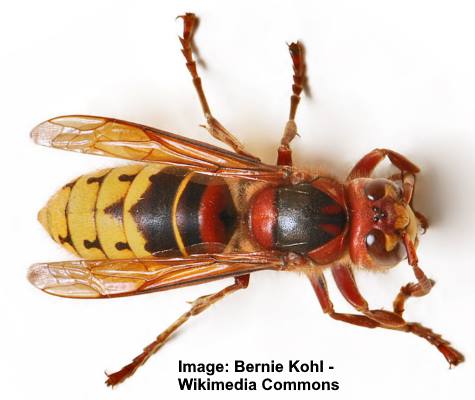
European Hornet (Vespa crabro)
The European hornet is a large, sometimes aggressive wasp easily identifiable by its yellow and brown abdominal stripes. Additionally, the large wasp has yellow to tan legs and a reddish-brown head and thorax. These wasps measure 1” to 1.4” (25 – 35 mm) long, and their reddish-brown wings have a span of 0.63” (16 mm).
European hornets are social insects that live in colonies and construct large grayish papery nests. These large flying insects can inflict a nasty bite when provoked. However, like all wasp species, male wasps cannot sting, but their erratic flying behavior makes them appear aggressive.
Wasp identification: The European hornet is identified by its large oval body with pronounced dull yellow bands on a brown abdomen. The males and females have a powerful flight pattern that produces loud buzzing noises.
Mud Daubers (Apoidea)

The black-and-yellow mud dauber wasp (Sceliphron caementarium)
Mud daubers are an unusual type of wasp easily recognized by their slender, needle-like waist. Depending on the species, the wasps can be black with yellow markings or have iridescent metallic colors. Mud dauber activity is usually recognized by the flute-like nests that resemble organ pipes they build from mud.
Mud daubers measure between 0.5” to 1” (13 – 25 mm) long. The non-aggressive wasps tend to leave people alone. However, they become a nuisance when provoked, but they rarely sting. The small, slender dark-colored wasps are active during spring and summer as they fly from plant to plant, feeding on nectar.
Wasp identification: Mud daubers can be identified by their long slender bodies, black and yellow or metallic colors, and thread-waisted bodies. Additionally, these solitary wasps build nests out of mud which can be found attached to walls or other structures.
Mexican Honey Wasp (Brachygastra mellifica)
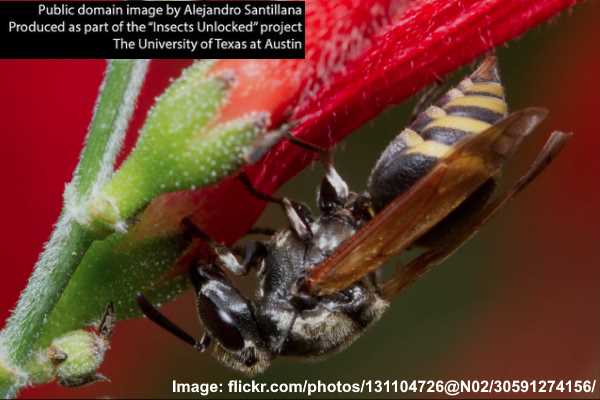
Mexican Honey Wasp (Brachygastra mellifica)
The Mexican honey wasp is a large, black and yellow flying insect with alternating bands on its pear-shaped abdomen. The unique feature of this tropical wasp is that it’s one of the few wasps native to North America that produces honey. This distinctive yellow and black Mexican honey wasp measures 0.27” to 0.35” (7 – 9 mm) long.
The Mexican honey wasp plays a vital role in ecosystems in the southern United States. The wasps pollinate flowers, especially those on avocado plants. Additionally, they feed on insects like caterpillars and aphids. And they produce honey that has a similar consistency and quality to honeybees.
Wasp identification: The Mexican honey wasp can be identified by its yellow stripes across its black tear-shaped abdomen.
Great Golden Digger Wasp (Sphex ichneumoneus)
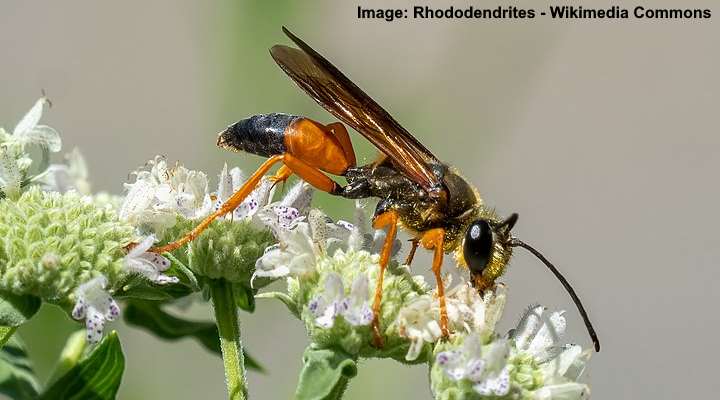
Great Golden Digger Wasp (Sphex ichneumoneus)
The great golden digger wasp is a relatively large wasp with an orange and black abdomen, black thorax, and orange legs. In addition, they have large black compound eyes on the side of their heads with a fuzzy golden band separating them. Typically these orange and black wasps measure 0.7” to 1” (18 – 25 mm) long.
Also called sand diggers, the wasps create nests by tunneling into the ground—hence the name, digger wasp.
Wasp identification: The great golden digger wasp is easily recognizable due to its black and orange abdomen and black head and thorax covered in short golden hairs.
Cuckoo Wasps (Chrysis spp.)
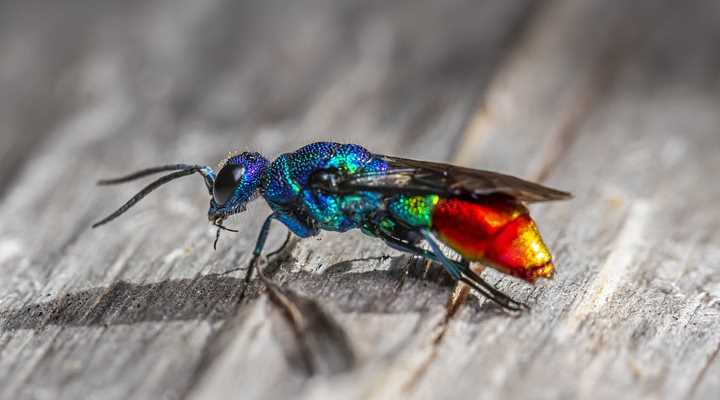
Cuckoo Wasps (Chrysis spp.)
Cuckoo wasps are a unique tropical wasp species, easily identified by their metallic blue or green colors. These iridescent-colored wasps have small, stout bodies, colorful legs, and straight, segmented antennae. Cuckoo wasps are small, measuring 0.19” to 0.31” (5 – 8 mm) long.
An interesting feature of these metallic-looking wasps is how they roll into a ball when attacked. Also, like cuckoo birds, these wasps lay their eggs in the nests of other wasps. They are active during summer, feeding on nectar and pollen from flowers.
Wasp identification: Cuckoo wasps are easy to identify due to their shiny metallic green, gold, or red bodies.
Four-Toothed Mason Wasp (Monobia quadridens)
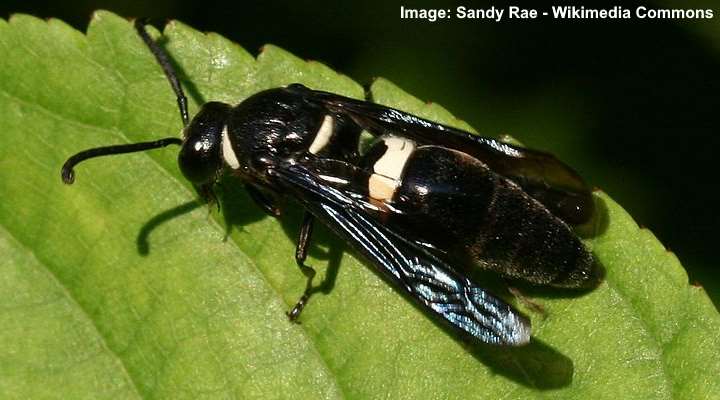
Four-Toothed Mason Wasp (Monobia quadridens)
The four-toothed mason wasp is identified as a black wasp with an ivory-white band across its shiny black abdomen. The jet-black wasp has a black head, wings, and legs. There are also recognizable white markings on the thorax and head of this medium-sized wasp.
The black wasp gets its name from the four teeth-like marking on the thorax. It measures 0.59” to 0.82” (15 – 21 mm) long with a wingspan of up to 0.57” (14.5 mm). The black wasps typically inhabit wooded areas and gardens.
Wasp identification: The species of black potter wasp has a shiny, jet-black body with a white band across the top of its abdomen.
Great Black Wasp (Sphex pensylvanicus)
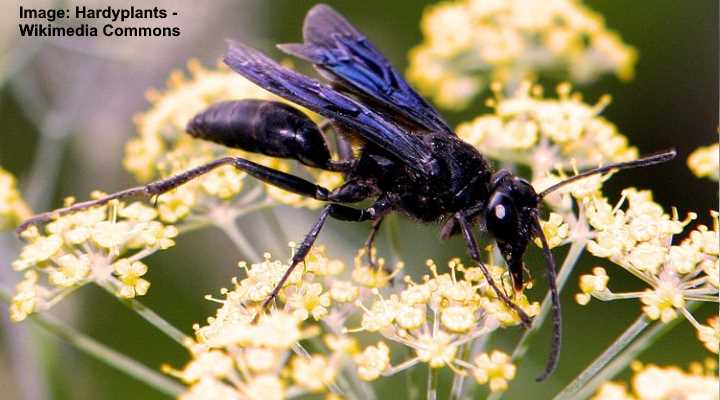
Great Black Wasp (Sphex pensylvanicus)
The great black wasp is a large, black wasp with steely-blue coloration, setting it apart from other wasps. The identifying features of the great black wasp are its thin waist—reminiscent of mud dauber wasps—large rounded thorax, and tear-shaped abdomen. Also, looking at pictures of the wasp, you’ll notice a small white spot on either side of this head.
This distinctive black wasp measures 0.8” to 1.4” (19 – 28 mm) long with a wingspan of up to 0.57” (14.5 mm). This species of digger wasp digs an underground nest where it feeds its young on the larvae of other insects. This black wasp species is related to the golden digger wasp.
Wasp identification: Identifying features of the great black wasp are its entirely black body, smoky wings, and large size of around 1.4” (35 mm).
Fraternal Potter Wasp (Eumenes fraternus)
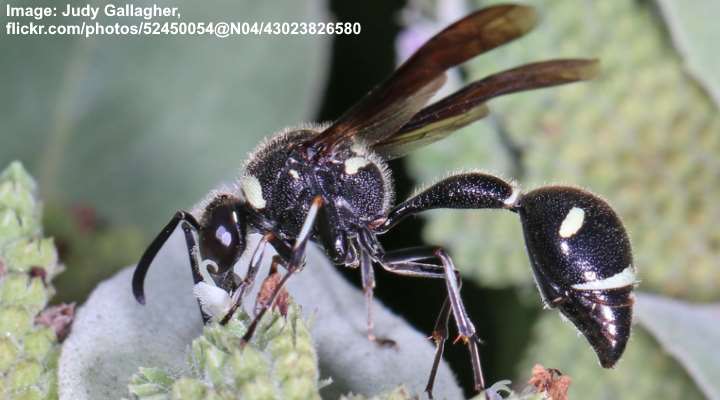
Fraternal Potter Wasp (Eumenes fraternus)
The fraternal potter wasp is a black wasp with an unusually thin waist, black bulbous abdomen, and rounded thorax. This potter wasp has recognizable white markings on its abdomen, hairy thorax, and a small oval head. In addition, it has black legs and angled antennae. These black and white wasps measure 0.6” to 0.8” (15 – 20 mm) long.
Wasp identification: The fraternal potter wasp is a slender black wasp with a relatively large abdomen and thorax in relation to its waist and head.
Tarantula Hawk Wasp (Pepsini)

Tarantula Hawk Wasp (Pepsini)
The tarantula hawk wasp is a huge species of spider hunting wasp with a blue-black body, brown, rust-colored wings, and vivid coloration on its body. This dark-colored stinging wasp can measure around 2” (5 cm), making it one of the largest wasps in North America. According to some reports, a sting from a tarantula hawk wasp is one of the most powerful of all insect stings.
The spider gets its name from its habit of attacking and killing tarantulas. However, the large black wasp is mostly docile and rarely attacks and stings humans. Even though the stings are extremely painful, they are rarely dangerous.
Wasp identification: The tarantula hawk wasp is identified by its large bluish-black body, rusty wings, and long black spindly legs.
Related articles:
